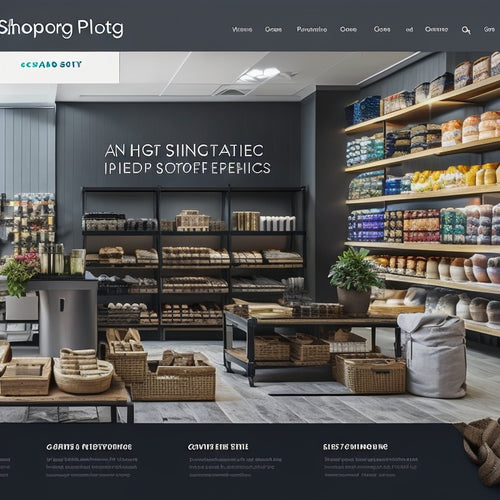
Retail Report Revealed: Key FAQs Answered
Share
The retail report serves as a valuable resource for stakeholders, providing essential statistics for decision-making and industry analysis. It covers various retail businesses, including store and nonstore retailers, across multiple categories like clothing, electronics, and food services. While national-level data is available, sub-national analysis is lacking. Estimates are derived from sampled data, necessitating consideration of sampling variability and reliability measures. Confidential respondent data is rigorously protected by the Census Bureau. With a thorough understanding of the report's scope and limitations, users can access its full potential and gain valuable insights into the US retail e-commerce landscape, leading to further exploration of its intricacies.
Key Takeaways
• The Retail Report provides vital statistics for stakeholders to make informed decisions, analyze industry trends, and measure market share.
• The report covers businesses under Retail Trade by NAICS, including store and nonstore retailers, and offers insights into various retailing methods.
• Statistics are available only at the national level, lacking sub-national analysis, and are derived from a sample, introducing variability.
• To accurately interpret estimates, it's crucial to understand sampling variability, standard error, and coefficient of variation to gauge reliability.
• The Census Bureau safeguards respondent data with strict confidentiality measures, cybersecurity, and data encryption to ensure secure and trusted data.
Understanding Report Users
A diverse range of stakeholders, including trade and professional associations, media outlets, private enterprises, and statistical programs, rely on the statistics presented in the Quarterly Retail E-Commerce Report to inform their decision-making processes. These stakeholders utilize the report's data to conduct industry analysis, identify market trends, and make informed decisions.
Trade and professional associations analyze industry trends to stay ahead of the curve, while media outlets use the data to craft informative news reports. Private enterprises, on the other hand, measure their market share and benchmark their performance against industry averages.
Businesses Covered in Report
The Quarterly Retail E-Commerce Report covers a wide range of businesses classified under Retail Trade by the North American Industry Classification System (NAICS), offering a detailed picture of the retail e-commerce landscape.
The report includes businesses that operate as Store retailers, selling merchandise from fixed point-of-sale locations, and Nonstore retailers, using various retailing methods.
- Retail classifications include:
- Clothing and clothing accessories stores
- Electronics and appliance stores
- Food services and drinking places
- General merchandise stores
- Health and personal care stores
Data Availability and Scope
Statistics from the Quarterly Retail E-Commerce Report are available solely at the national level, providing an extensive overview of the retail e-commerce landscape across the United States. This report does not provide sub-national analysis, which means data is not available at the state or local level. The report's scope covers firms classified in Retail Trade by NAICS, including store and nonstore retailers.
| Level of Data | Availability | Scope |
|---|---|---|
| National | Available | Entire retail e-commerce landscape |
| Sub-national (state, local) | Not available | Not applicable |
| Firm-level | Not available | Confidentiality measures |
| Sampling methods | Used | To produce estimates |
The report's data is based on sampling methods, which may introduce variability in the estimates. It is essential to understand the scope and limitations of the report to accurately interpret the data.
Interpreting Report Estimates
Estimates in the Quarterly Retail E-Commerce Report are derived from a sample of the population, rather than the entire population, which may introduce variability in the published values. When interpreting report estimates, it is important to take sampling variability into account to guarantee accurate data interpretation.
-
Sampling variability is a critical aspect of data interpretation, as it impacts the reliability of estimates.
-
Measures of variability, such as sampling variance and standard error, provide insight into the accuracy of estimates.
-
The coefficient of variation (CV) expresses standard error as a percentage, allowing for comparison of the reliability of different estimates.
-
Understanding sampling variability is essential for making informed decisions based on report estimates.
-
By acknowledging and addressing sampling variability, users can ensure that their data interpretation is accurate and reliable.
Protecting Confidential Data
Respondent information is safeguarded by the Census Bureau through strict confidentiality measures, guaranteeing that data is used solely for statistical purposes and cannot be publicly released in a way that identifies a business. This commitment to data protection is essential for maintaining trust among respondents.
| Confidentiality Measures | Description | Purpose |
|---|---|---|
| Cybersecurity measures | Protect data from risks | Ensure data security |
| Data encryption | Secure data transmission | Prevent unauthorized access |
| Access controls | Limit data access | Prevent data misuse |
The Census Bureau's robust cybersecurity measures and data protection protocols ensure that respondent data remains confidential, allowing businesses to provide accurate information without fear of exposure. By prioritizing data protection, the Census Bureau guarantees the integrity of its statistical programs and maintains the trust of its respondents.
Frequently Asked Questions
Can I Use Past Reports to Identify Long-Term Retail Trends?
Historically, online retail sales have grown by 15% annually, indicating a significant shift in consumer behavior. By analyzing past reports, businesses can identify long-term retail trends, informing retail forecasting and market analysis, and providing valuable industry insights to drive strategic decision-making.
How Often Is the Quarterly Retail E-Commerce Report Published?
The Quarterly Retail E-commerce Report is published every quarter, providing timely retail analysis and industry insights for market research and consumer behavior studies, enabling businesses to stay informed and adapt to shifting market trends.
What Is the Average Response Rate for the Survey?
The average response rate for the Quarterly Retail E-commerce Report survey is not publicly disclosed; however, response rate analysis is essential for data accuracy, and high survey participation guarantees industry benchmarks are reliable and thorough.
Are the Report's Estimates Adjusted for Seasonal Fluctuations?
The age-old conundrum: do the report's estimates account for those pesky seasonal fluctuations? Fear not, dear reader, for the answer is a resounding 'yes!' Seasonal adjustments are indeed applied to guarantee forecasting accuracy in retail sales analysis and market trend analysis.
Can I Request Custom Data or Special Tabulations?
The Census Bureau offers custom analysis and special insights through the Customer Liaison and Marketing Services Office, providing tailored data solutions for a fee, while ensuring confidentiality and data protection.
Related Posts
-

3 Best Ecommerce Scaling Strategies for Rapid Growth
You're stuck in neutral if your ecommerce business isn't scaling rapidly, and it's likely due to inefficient operatio...
-
A Guide to Shopify Sitemaps
This article presents a comprehensive guide to Shopify sitemaps, focusing on their benefits for search engine optimi...
-

What Does It Take to Succeed in Shopify
Shopify, a popular e-commerce platform, offers numerous benefits and opportunities for success. This article aims to...

